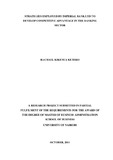| dc.description.abstract | Competitive advantage is a position that a firm occupies against its competitors.
Sources of competitive advantages include government subsidy or support,
monopolistic markets, innovation, operational efficiencies, superior service offering
and highly skilled human capital. Banks are competing with mobile phone operators’
money transfer services like Safaricom's (M-Pesa) and Zain's (Zap). Competition is
likely to intensify in the banking industry in the background of a shrinking economy.
Past studies have illustrated the power of competitive strategies on companies
operating in a competitive environment. However, there still exists dearth literature,
especially one that has in-depth evaluated the competitive advantage of Imperial Bank
Kenya. The specific objectives of this study are; to determine the strategies used by
Imperial Bank to respond to competition in the Kenyan banking industry and the
challenges the bank is facing on the implementation of these strategies. The theories
that underline this current study are; strategic leadership, scientific management
theory and competitive theory. Case study research design was used given that the
unit of analysis is based on one organization. Primary data was used in the study by
use of an interview guide. Content analysis was used to make analysis of the
qualitative data. The most notable competitive strategies adopted by Imperial Bank
Kenya include diversification, good corporate governance, new products and services,
products and services differentiation, market segmentation, acquisition, branch
network expansion, automation of business processes, innovation, improved customer
service, strategic partnerships, marketing and staff training. The challenges in
implementation of these competitive strategies include lack of coordination and
support from other levels of management, employee resistance to change and lack of
proper planning in formulation and implementation of strategies. The study concluded
that the bank embraces; financial, growth, product differentiation, strategic
partnership, ICT, marketing and human resources strategies to gain competitive
advantage. The study also concluded that banks face challenges of lack of adequate
resources to implement desired strategies, there are internal politics hindering strategy
implementation and that lower level staffs are not involved in policy formulation
hence difficulty in implementation in the bank. The study recommends that Imperial
bank should quickly adopt agency banking in order to increase their branch network
and that organizations building on competitive advantage should create higher level of
involvement of members; that is managers and employees in the organization. The
research did not entirely look at the challenges faced in implementation of these
competitive strategies thus a limitation. Further, the study did not look at other
competitive variables in depth such as human resource strategies and ICT strategies in
achievement of competitive advantage.The study recommends future studies to touch
other competitive strategic responses adopted by Imperial Bank, further, analysis of
the functions of managers in achievement of competitive advantage and competition
strategies among banks/financial institution is an area that can be explored. | en_US |

